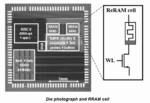You are currently viewing SemiWiki as a guest which gives you limited access to the site. To view blog comments and experience other SemiWiki features you must be a registered member. Registration is fast, simple, and absolutely free so please,
join our community today!
Make a difference and take this short survey. It asks about your experience with embedded non-volatile memory technologies. The survey is anonymous, and the results will be shared in aggregate to help the industry better understand trends: 2025 Embedded Non-Volatile Memory Survey.
We are now in the AI era where data is the lifeblood… Read More
Resistive RAM (ReRAM or RRAM) is the strongest candidate for next-generation non-volatile memory (NVM), combining fast switching speeds with low power consumption. New techniques for managing a memory phenomenon called ‘relaxation’ are making ReRAM more predictable — and easier to specify for real-world applications.… Read More
One-time programmable (OTP) non-volatile memory has been around for a long time. Compared to other non-volatile memory technologies OTP has a smaller footprint and does not require additional manufacturing steps, making it a popular choice to store items such as boot code and encryption keys. While this sounds simple, the growth… Read More
Embedded memory makes computing applications run faster. In the early days of the semiconductor industry, the desire to utilize large amount of on-chip memory was limited by cost, manufacturing difficulties and technology mismatches between logic and memory circuit implementations. Since then, advancements in semiconductor… Read More
RRAM Reduxby Bernard Murphy on 11-04-2016 at 7:00 amCategories: IP
Advanced memory technologies are a perennially hot topic thanks to a proliferation of data-hungry applications pushing our demand for more capacity and performance at less power and area. Among several technology contenders is Resistive RAM or RRAM (also called ReRAM). In this technology a conducting filament is grown through… Read More
The 2016 edition of the Flash Memory Summit produced more than the usual amount of excitement. Samsung’s response to the Intel/Micron 3D XPoint challenge arrived in new slideware, indicating the war for next-generation SSDs is just starting. Who has the advantage?
We’d all like to think this is about creating a breakthrough technology,… Read More
IHS has put out its 1Q2016 Application Market Forecast predicting the highest growth rate segments for semiconductors over the next five years – and what was once old is new yet again. There it is, in the top right corner: industrial, projected to outpace even the automotive sector.… Read More
Timeo Danaos et dona ferentes. I fear the Greeks especially when bearing gifts. In Virgil’s Aeneid these words are spoken by the Trojan priest Laocoön warning about the wooden horse that the Greeks have offered Troy. But to no avail, Laocoön is slain by serpents and the Trojans bring the horse inside the walls of Troy. Since… Read More
Process shrinks, which have served us well for most of the Moore’s Law journey, are reaching their limits. For switching transistors, the biggest problems of leakage current and gate oxide vulnerability in planar MOSFETs have led the industry to new 3D microstructures such as FinFET. For non-volatile memory, the problem is generally… Read More
Maybe I’ve spent too many years whiffing solder flux fumes and absorbing doses of X-band radiation in anechoic chambers, but I’m a firm believer in the axiom: “Give me enough engineers, and I can get 10 of anything to work right, once.” We have to make this … fit into this … using only this stuff … is what legends are made of.… Read More





